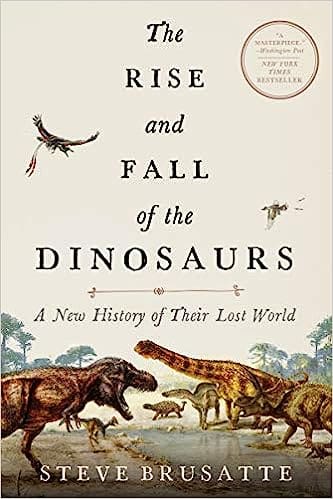The Rise and Fall of the Dinosaurs: A New History of Their Lost World

Embark on an epic journey through time and discover the fascinating world of dinosaurs with The Rise and Fall of the Dinosaurs: A New History of Their Lost World by Steve Brusatte. Don’t miss out on this captivating narrative – grab your copy today!
Features
- Written by a Renowned Paleontologist: Authored by Steve Brusatte, a leading figure in the field of Paleontology, who has named 15 new species and led groundbreaking scientific studies.
- Comprehensive: This book covers the entire 200-million-year-long story of dinosaurs, from their origins to their extinction.
- Illustrated: Includes more than 70 original illustrations and photographs to help visualize the dinosaurs and their world.
- Extras: Includes world maps of the prehistoric earth and a dinosaur family tree.
Problems It Solves
- Knowledge Gap: Fills the gap in most people’s understanding of the dinosaur era, providing a comprehensive overview of this significant period in Earth’s history.
- Engages Young Learners: With its captivating narrative and illustrations, the book can spark children’s interest in paleontology and natural history.
- Bridges the Past and the Present: The book not only explores past events but also draws parallels with the present, helping readers understand the relevance of the study of dinosaurs to today’s world.
I. Introduction
Have you ever wondered how we know so much about Earth’s past? The secrets lie beneath the surface, in the fossils and geological records that make up the exciting field of paleontology. Understanding “The Role of Paleontology in Understanding Earth’s History” is key to unlocking the mysteries of our world’s past.
II. What is Paleontology?
Paleontology is the scientific study of life that existed prior to our record of human history. It involves the examination of plant and animal fossils to reconstruct the history and processes of biological evolution. Paleontologists, the scientists who study this field, provide us with a unique window into Earth’s prehistoric past.
III. The History of Paleontology
The roots of paleontology stretch back to the curious minds of ancient civilizations, but it was not until the 19th century that it became a recognized scientific discipline. Key fossil discoveries have shaped our understanding of Earth’s history, from the giant reptiles of the Mesozoic era to the early hominids of Africa.
IV. How Paleontology Helps us Understand Earth’s History
Paleontology is like a time machine, transporting us millions of years back when dinosaurs roamed the Earth or when the first plants colonized land. By studying fossils, paleontologists can reconstruct past ecosystems, track the evolution of species over time, and determine the age of rocks in the geological timeline.
Moreover, paleontology plays a crucial role in studying prehistoric climate conditions. By examining the remains of ancient plants and animals, scientists can infer past climate and environmental changes, aiding our understanding of current climate change trends.
V. Current Challenges in Paleontology
Despite its significance, paleontology faces several challenges. Limited funding often hinders research and excavation projects. Climate change poses a threat to fossil preservation. Accessibility to important fossil sites can often be problematic due to geopolitical issues. Overcoming these challenges is critical to furthering our understanding of Earth’s history.
VI. How Paleontology Benefits Society
Paleontology’s benefits extend beyond academia. It plays a crucial role in enlightening us about climate change and biological evolution. By studying past climate patterns, we can predict future trends and prepare accordingly. In education, paleontology sparks curiosity and fosters an appreciation for science among children and adults alike.
VII. Recommended Resources
If you’re interested in learning more about paleontology, consider reading The Rise and Fall of the Dinosaurs: A New History of a Lost World by Steve Brusatte. Available on Amazon, it offers an engaging look at the world of dinosaurs and the scientists who study them.
VIII. Conclusion
Understanding “The Role of Paleontology in Understanding Earth’s History” is more than just an academic endeavor. It’s a journey into our planet’s past, offering insights into the present and predictions for the future. So, the next time you come across a fossil, remember it’s not just a rock – it’s a window into the ancient world.
Other Articles
I appreciate you taking the time to delve into “The Role of Paleontology in Understanding Earth’s History”. I trust you found it informative and captivating. Do consider sharing it to spread the knowledge. If you’re intrigued and want to explore more, here are some additional articles from sunnydaysgo.com that might pique your interest:
- Unfolding Earth’s Past: A Deep Dive into Fossils
- Heat and Its Role in Climate Change: A Deep Dive
- The Importance of Temperature in Our Changing Climate
- Top 10 Best Hiking Trails Around the World
- Glossary Term: When Is Father’s Day?
